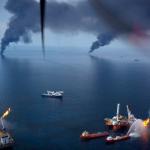Five Years After the Deepwater Horizon Oil Spill, We Are Closer Than Ever to Catastrophe

In the five years since the Deepwater Horizon accident, the oil and gas industry has not retreated to safety. Instead, it has expanded its technological horizon in ways that make it harder to foresee the complex interactions between drilling technologies, inevitable human errors and the ultra-deepwater environment.
Before its sinking, Deepwater Horizon had drilled one of the deepest oil and gas wells. That depth has since been surpassed, and exploration continues to new frontiers. Not far from the Deepwater Horizon accident site, Royal Dutch Shell is now developing the deepest offshore oil field in history. In the Caspian Sea, an international consortium is exploring the Kashagan oil and gas field, a mega-project that the consortium itself describes as an enormously challenging endeavour. And the hunt for Arctic oil takes place in some of the most inhospitable waters in the world.
Numerous analyses of the Deepwater Horizon accident have pointed to three contributing causes: the complexity and inherent riskiness of oil drilling systems, human and organisational factors and regulatory challenges. In the past half-decade, we have made little progress in these areas. Indeed, the risk of another catastrophic spill may be greater than ever before.
Offshore drilling is a complex system prone to technological failures that are difficult to predict and challenging to comprehend in real-time. Drilling operations have limited slack to absorb errors; the failure of one part of the system can spread quickly to other parts, and operators cannot simply “turn off the well” while they look for a solution. Unfortunately, major accidents are nearly inevitable in these kinds of systems, as decades of research by Yale sociologist Charles Perrow has shown.
Human and organisational factors compound these challenges. A well-documented and particularly pernicious tendency of human decision-makers is to interpret evidence in a way that supports their pre-existing conclusions (pdf).
This was one of many factors in the Deepwater Horizon accident, as operators misinterpreted the results of critical safety tests on the night of the accident. They saw what they expected – and wanted – to see. Additionally, under the false assumption that well cementing had gone smoothly, the BP team decided to skip a cement evaluation test earlier in the day, thus saving $128,000 (£86,000) in contractor fees and potentially shortening the lease period of the costly rig. These mistakes, of course, did not occur in a vacuum. They occurred in a culture that focused on minimising costs and preventing occupational injuries (pdf) at the expense of an emphasis on preventing catastrophe.
Though engineering fixes have since been implemented (and additional rules recently proposed) to solve some of the specific problems that Deepwater Horizon experienced, cultural and organisational root causes have received less attention in the industry. This is a pattern we see all too often in the wake of catastrophic events. An engineering solution is quickly developed to treat the technological symptoms, but the organisation managing the dangerous technology changes little. Then, as time passes, the initial post-disaster period of caution gradually gives way to increasingly bullish overconfidence – until the next disaster strikes.
On the regulatory front, important changes have occurred since 2010, but the pace of change is slow. The Minerals Management Service has been separated into distinct agencies, reducing conflicts of interest that came from combining revenue generation and regulatory oversight. Its regulatory successor, the Bureau of Safety and Environmental Enforcement (BSEE), has begun to make important changes, such as requiring more comprehensive approaches to drilling safety. But the agency still leans heavily on inspections and prescriptive regulations. Studies of the offshore drilling industry reveal that more effective inspection regimes do not necessarily reduce the likelihood of incidents. This is partly because inspections become rote procedures, with little effect on systemic safety. Safety requires a collaborative culture of information sharing, but research shows that punitive measures hinder the development of such a culture by discouraging the reporting problems for fear of punishment.
To promote information sharing, the BSEE has announced the creation of a confidential industry-wide system to track near misses. The insights afforded by such a system could lead to tangible regulatory changes that improve industry safety. But the system is not yet operational, having missed the intended implementation date by six months (and counting).
Recent incidents and near-misses paint a dark picture. In November 2012 there was a deadly explosion and fire on an oil platform in the Gulf of Mexico. A few weeks later, Shell’s drilling rig Kulluk ran aground on the Alaskan coast due to what the US Coast Guard described as “inadequate assessment and management of risks”. In July 2013 a drilling rig partially collapsed because of a ruptured natural gas well off the Louisiana coast.
We are now five years on from the last catastrophe. Without fundamental organisational and regulatory changes in the oil and gas industry, each day brings us closer to the next one.
András Tilcsik is an assistant professor and fellow at the Lee-Chin Institute at the Rotman School of Management, University of Toronto. Chris Clearfield is a principal at System Logic, a consulting firm focused on risk management in complex systems.
